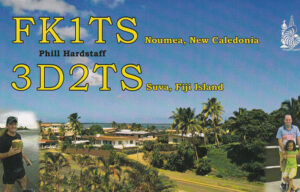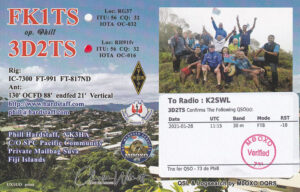
 3D2TS
3D2TS
Suva, Fiji
28-Jan-21, 20m FT8, Loc: RH91fv, IOTA: OC-016
QSL card received via QSL Manager M0OXO. Op. Phill Hardstaff also verified via LOTW and eQSL.cc. Thank you, Phill!
 Radio 48 via Sycko
Radio 48 via Sycko
North American Pirate
5140 kHz USB
Full-date eQSL in less than 24 hours after broadcast via report on HFU. Very nice! Program was a tribute to Toots Hibbert of the legendary Toots and the Maytals reggae band. Toots passed away yesterday in Kingston after a battle with Covid. The show also consisted of some Kracker’s old Radio Jamaba Int’l material which was pretty awesome.
Thank you, thank you very much!
 Radio 48
Radio 48
North American Pirate
6880 USB
Full-date eQSL in less than 24 hours after broadcast via report on HFU. Very nice! Thank you, thank you very much!
Shortwave Radiogram decode
via WRMI, 7780 kHz, Jun 14 2020, 2330 UTC
[Mode: MFSK32]
Welcome to program 156 of Shortwave Radiogram.
I’m Kim Andrew Elliott in Arlington, Virginia USA.
Here is the lineup for today’s program, in MFSK modes as noted:
1:46 MFSK32: Program preview (now)
2:55 Long-lost dragon lizard rediscovered*
10:08 MFSK64: Method to extract CO2 from atmosphere, make fuel*
14:38 This week’s images*
27:59 MFSK32: Closing announcements
* with image(s)
Please send reception reports to radiogram@verizon.net
And visit http://swradiogram.net
Twitter: @SWRadiogram
From Science News:
A nose-horned dragon lizard lost to science for over 100 years
has been found
Dyna Rochmyaningsih
9 June 2020
Nearly 130 years ago, Italian explorer Elio Modigliani arrived at
a natural history museum in Genoa with a lizard he’d reportedly
collected from the forests of Indonesia.
Based on Modigliani’s specimen, the striking lizard – notable for
a horn that protrudes from its nose – got its official taxonomic
description and name, Harpesaurus modiglianii, in 1933. But no
accounts of anyone finding another such lizard were ever
recorded, until now.
In June 2018, Chairunas Adha Putra, an independent wildlife
biologist conducting a bird survey in a mountainous region
surrounding Lake Toba in Indonesia’s North Sumatra, called
herpetologist Thasun Amarasinghe. Near the lake, which fills the
caldera of a supervolcano, Putra had found “a dead lizard with
interesting morphological features, but he wasn’t sure what it
was,” says Amarasinghe, who later asked the biologist to send the
specimen to Jakarta.
It took only a look at the lizard’s nose-horn for Amarasinghe to
suspect that he was holding Modigliani’s lizard. “It is the only
nose-horned lizard species found in North Sumatra,” he says.
Wooden arts and folktales of the Bataks – indigenous people
native to the region – show that lizards have a special place in
the people’s mythology. “But simply there was no report at all
about this species” following Modigliani’s, says Amarasinghe, of
the University of Indonesia in Depok.
He asked Putra to get back to the caldera to see if there was a
living population. After five days, Putra found what he was
looking for one evening, “lying on a low branch, probably
sleeping,” according to the biologist. He took pictures of the
lizard and measured the size and shape of its body parts, such as
the length of its nose-horn and head. He also observed its
behavior before finally releasing it the same night.
Using this data, Amarasinghe compared the lizard with the one
described in 1933, and concluded that the living lizard and the
dead one that Putra had stumbled across were in fact Modigliani’s
nose-horned lizards. The Genoa museum’s dead specimen is pale
blue due to preservation, but it’s now known that the lizard’s
natural color is mostly luminous green. Its camouflage and
tree-dwelling behavior are similar to African mountain
chameleons, Amarasinghe, Putra and colleagues report in the May
Taprobanica: The Journal of Asian Biodiversity.
The reptile belongs to the Agamidae family of lizards, which are
commonly called dragon lizards and include species such as
bearded dragons. Shai Meiri, a herpetologist at Tel Aviv
University, has previously shown that many dragon lizards live in
small, hard-to-access areas, making the reptiles difficult to
study. There are 30 agamid species that have never been seen
since they were first described, and 19 species which are known
from just a single specimen, Meiri says.
While thrilled with their find, Amarasinghe and Putra are worried
about the lizard’s future. “The living dragon was found outside a
conservation area, and massive deforestation is happening
nearby,” Amarasinghe says.
But the rediscovery offers a glimmer of hope for the lizard’s
conservation, Meiri says. Before the reptile resurfaced, no one
knew where exactly Modigliani’s lizard lived, or whether it had
already gone extinct, he says. But now, “we can study it,
understand its conservation needs and hopefully implement
conservation measures.”
https: //www.sciencenews.org/article/nose-horned-dragon-lizard-lost-science-found
Image: Modigliani’s lizard is notable for the horn that emerges
from its nose …
Sending Pic:206x116C;
Shortwave Radiogram changes to MFSK64 …
[Mode: MFSK64]
This is Shortwave Radiogram in MFSK64
Please send your reception report to radiogram@verizon.net
From New Atlas:
BMW invests in technology to pull gasoline out of the air
C.C. Weiss
9 June 2020
BMW i Ventures, BMW’s hybrid venture firm, announced today it is
investing in Prometheus Fuels. The Silicon Valley startup is
working on technologies for pulling CO2 out of the atmosphere and
processing it into carbon-neutral gasoline. The investment will
help the company as it prepares for retail launch as early as
late 2020.
Launched in 2019 by Rob McGinnis, a Yale Engineering PhD and
startup veteran, Prometheus Fuels is refining processes and
technologies for capturing CO2 from the air and processing it
into gasoline, diesel and jet fuels that work with existing
vehicles. According to the company, its processes are carbon
neutral, 100 percent powered by solar and wind energy. Using its
proprietary capture, fuel synthesis and fuel separation
technologies, the company says it’s able to create fuel that is
molecularly identical to oil-based gasoline.
Given its beginnings as captured CO2, Prometheus’ fuel does not
add any net CO2 to the atmosphere from tailpipe emissions, making
it a zero-net-carbon fuel. Furthermore, it prevents the
extraction of oil and natural gas that would otherwise be
necessary to create the same amount of gasoline.
Unlike other sustainable fuels that require vehicle
modifications, Prometheus’ gasoline is designed to work
seamlessly with existing internal combustion engines, allowing
buyers to simply choose it at the pump, fill up and go.
Prometheus’ goal is to price it at the same level as traditional
gasoline before bringing price down over time so there’s no price
penalty for its use, either.
“The ability to create gasoline from air, cost competitively with
fossil fuels, is a game changer,” said Greg Smithies, Partner,
BMW i Ventures. “The average car stays on the road for over eight
years, meaning that even if the whole world switched to buying
100 percent electric cars tomorrow, it would still take almost a
decade for today’s internal combustion engines to be off the
road. By creating carbon-neutral gasoline from CO2 captured from
the air, Prometheus Fuels allows the climate impact of today’s
internal combustion engines to be massively reduced immediately.”
Prometheus estimates that if all fuels made from oil and gas were
replaced with its style zero-net-carbon fuel, the world would see
a 10-gigaton reduction in CO2 emissions per year, roughly 25
percent of global emissions. The company says that BMW i
Ventures’ investment led a funding round of $12.5 million.
“BMW i Ventures investment will help us to accelerate our efforts
to bring our zero-net-carbon fuel to market quickly,” said
McGinnis.
Prometheus hopes to begin selling its fuel at California retail
pumps later this year, expanding to other US and international
markets in 2021. It says it is also working on related
technologies for CO2 removal and sequestering.
Sources: BMW, Prometheus
https: //newatlas.com/environment/bmw-prometheus-fuels-investment/
Prometheus Fuels uses an old gasoline pump to promote its product
…
Sending Pic:194x172C;
 This is Shortwave Radiogram in MFSK64
This is Shortwave Radiogram in MFSK64
Please send your reception report to radiogram@verizon.net
This week’s images …
One of the finalists in the 2020 Sony World Photography Awards is
Argentinian José De Rocco. This is one of his photos of exterior
walls in South America. From https: //bit.ly/2UyPliT …
Sending Pic:138x208C;
Sunrise at Nyona Lake in northern Indiana. From
https: //bit.ly/2AfK4pJ …
Sending Pic:205x151C;
One of several photos from a Washington Post article about
lightning hitting the Washington Monument. From
https: //wapo.st/2Uyomny …
Sending Pic:203x167C;
A deer flees flames as the Quail Fire burns near Winters,
California, 6 June. From https: //bit.ly/3dTxYkr …
Sending Pic:209x103C;
In London, an image of Charles Dickens is projected on to the
west towers of Westminster Abbey to mark the 150th anniversary of
his death. From https: //bit.ly/2B0sqGa …
Sending Pic:185x193C;
In Lausanne, Switzerland, a nightclub transformed into a
?tcwr9eˆ as hygiene measures ute{rb the spread of Covid-19
still discourage the usual clubbing experience. From
https: //bit.ly/30yCIrN …
Sending Pic:180x205C;
Our art of the week is digital artwork at teamLab Planets in
Tokyo, viewed by visitors on the day of the museum’s reopening.
From https: //bit.ly/37n18Gs …
Sending Pic:205x152C;
Shortwave Radiogram returns to MFSK32 …
[Mode: MFSK32]
This is Shortwave Radiogram in MFSK32 …
Shortwave Radiogram is transmitted by:
WRMI, Radio Miami International, wrmi.net
and
WINB Shortwave, winb.com
Please send reception reports to radiogram@verizon.net
And visit http://swradiogram.net
Twitter: @SWRadiogram or twitter.com/swradiogram
I’m Kim Elliott. Please join us for the next Shortwave
Radiogram.